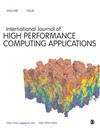Efficient exascale discretizations: High-order finite element methods
IF 2.5
3区 计算机科学
Q2 COMPUTER SCIENCE, HARDWARE & ARCHITECTURE
International Journal of High Performance Computing Applications
Pub Date : 2021-06-08
DOI:10.1177/10943420211020803
引用次数: 30
Abstract
Efficient exploitation of exascale architectures requires rethinking of the numerical algorithms used in many large-scale applications. These architectures favor algorithms that expose ultra fine-grain parallelism and maximize the ratio of floating point operations to energy intensive data movement. One of the few viable approaches to achieve high efficiency in the area of PDE discretizations on unstructured grids is to use matrix-free/partially assembled high-order finite element methods, since these methods can increase the accuracy and/or lower the computational time due to reduced data motion. In this paper we provide an overview of the research and development activities in the Center for Efficient Exascale Discretizations (CEED), a co-design center in the Exascale Computing Project that is focused on the development of next-generation discretization software and algorithms to enable a wide range of finite element applications to run efficiently on future hardware. CEED is a research partnership involving more than 30 computational scientists from two US national labs and five universities, including members of the Nek5000, MFEM, MAGMA and PETSc projects. We discuss the CEED co-design activities based on targeted benchmarks, miniapps and discretization libraries and our work on performance optimizations for large-scale GPU architectures. We also provide a broad overview of research and development activities in areas such as unstructured adaptive mesh refinement algorithms, matrix-free linear solvers, high-order data visualization, and list examples of collaborations with several ECP and external applications.高效百亿亿次离散化:高阶有限元方法
高效利用百亿亿次架构需要重新思考在许多大规模应用程序中使用的数值算法。这些体系结构倾向于暴露超细粒度并行性和最大化浮点操作与能源密集型数据移动的比率的算法。在非结构化网格上实现PDE离散化的少数可行方法之一是使用无矩阵/部分组装的高阶有限元方法,因为这些方法可以提高精度和/或降低计算时间,因为减少了数据运动。在本文中,我们概述了高效百亿亿次离散化中心(CEED)的研究和开发活动,该中心是百亿亿次计算项目中的协同设计中心,专注于开发下一代离散化软件和算法,以使各种有限元应用程序能够在未来的硬件上高效运行。CEED是一个研究伙伴关系,涉及来自两个美国国家实验室和五所大学的30多名计算科学家,包括Nek5000, MFEM, MAGMA和PETSc项目的成员。我们讨论了基于目标基准、微型应用程序和离散化库的CEED协同设计活动,以及我们在大规模GPU架构的性能优化方面的工作。我们还提供了在非结构化自适应网格细化算法、无矩阵线性求解器、高阶数据可视化等领域的研究和开发活动的广泛概述,并列出了与几个ECP和外部应用程序合作的示例。
本文章由计算机程序翻译,如有差异,请以英文原文为准。
求助全文
约1分钟内获得全文
求助全文
来源期刊
CiteScore
6.10
自引率
6.50%
发文量
32
审稿时长
>12 weeks
期刊介绍:
With ever increasing pressure for health services in all countries to meet rising demands, improve their quality and efficiency, and to be more accountable; the need for rigorous research and policy analysis has never been greater. The Journal of Health Services Research & Policy presents the latest scientific research, insightful overviews and reflections on underlying issues, and innovative, thought provoking contributions from leading academics and policy-makers. It provides ideas and hope for solving dilemmas that confront all countries.

 求助内容:
求助内容: 应助结果提醒方式:
应助结果提醒方式:


